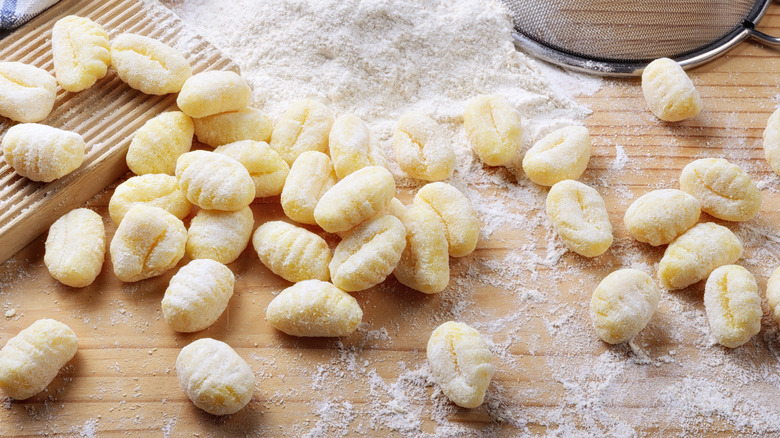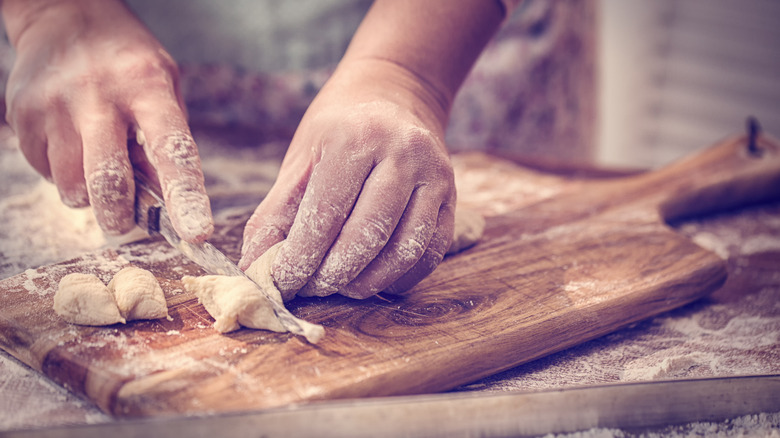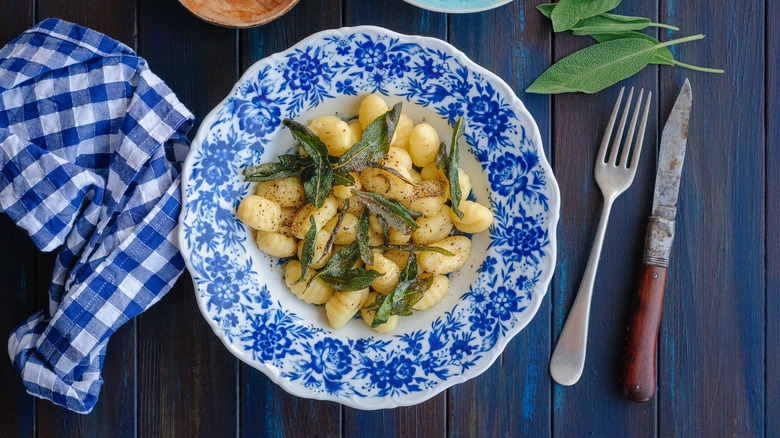The Ingredient Tip That Makes For Fluffier Gnocchi
The classic Italian specialty known as gnocchi is as fun to eat as it is to try to get your friends to say out loud. When making it at home though, it can be a bit confusing as various types of gnocchi abound, as do the definitions of what exactly makes a gnoccho (singular in Italian). Probably the most common formula for these little bites includes potato that has been boiled, peeled, and riced, then combined with egg, flour, cheese, or other flavorings. This makes for a very delicious and filling meal, but an occasionally labor-intensive process with a lot of variables that leave room for error.
The truth is that the best, most light and fluffy gnocchi you can possibly create is a whole lot easier than you think. The key is to simplify: eliminate a few ingredients and steps, along with specialty tools, by taking this advice: omit the egg, and swap the potato for creamy and luscious whole-milk ricotta.
Understanding and executing this easy gnocchi recipe
It may seem like a bold move to go against the traditional potato preparation, but there's sound science behind this one. Egg is used in a gnocchi recipe to bind your ingredients, but a combination of creamy ricotta and grated cheeses will get the job done when it comes to holding your dough together. Removing the egg means you'll have less moisture to contend with, and thus you'll need less flour in your formula. With less flour comes less gluten development, which can be the culprit in making your gnocchi tough and chewy. Exercising restraint with flour will result in a tender, fluffy, light-as-air experience.
So while it can seem intimidating to make such an impressive dish, these dumplings are as easy to make as they are to devour. All you'll need is whole milk ricotta, grated cheese (like Pecorino Romano, Parmigiano-Reggiano, or Grana Padano), a bit of all-purpose flour, salt and pepper to taste, and your hands.
Kneading these ingredients together by hand gives you an advantage, not only because you won't have to pull out or invest in a stand mixer, but because you will also be able to feel this delicate dough as you work. If it's too sticky, you can add a bit of flour; if it's too dry, a splash of water. The finished product should be a pliable ball of dough that's firm enough to easily shape into those iconic little pillows.
Enjoying your fresh, hand-made gnocchi
Using ricotta, grated cheese, and white flour provides a blank slate for these soft bites because, in comparison to the richer potato and egg, it makes for a more neutral dough. But don't worry about it lacking flavor because you can always infuse some into the dough with herbs and spices. Nutmeg is a classic addition, but a bit of spicy chili powder for a kick, or turmeric for color and flavor. Compound butters can also be a fast and easy way to dress your dish. For something classic, sage and browned butter is a tried-and-true combination, but garlic and basil, or lemon and mixed herbs are excellent complements to the ricotta and cheese flavors in this preparation.
If, on the other hand, you're feeling more like a sauce, you can't go wrong there either. Tossed the gnocchi with your favorite pesto for a bright summer option or a simmered ragu for cooler months. Gnocchi can be a side dish, a starter course, or a main, especially when fortified with pancetta, sausage, or meatballs. Your cooking technique will also give you some creative license. Boiling as you would pasta is a pretty classic method, but you can also pan-fry for a crisp exterior, or even you can turn them into a fun and snackable appetizer by air frying your gnocchi and serving with a marinara dipping sauce.


